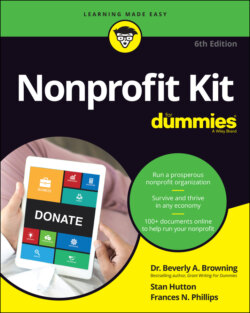Читать книгу Nonprofit Kit For Dummies - Stan Hutton, Beverly A. Browning - Страница 68
Incorporating diversity, equity, and inclusion in the board’s composition
ОглавлениеEvery governing board should represent the community-at-large that your new nonprofit organization plans to serve. For example, you’re planning to locate your new nonprofit in Tucson, Arizona. Before you start recruiting board members, take the time to research the most recent US census demographics for the city, town, village, hamlet, or region where services will be provided. Table 3-1 takes a look at the most recent demographics for what ethnic groups are represented in Tucson’s population. Note: The board recruitment metrics to meet are calculated based on a 9-member board of directors. The number of board members should always be an odd number so that it’s easier to have a board member quorum (majority) in order to start meetings and have a majority of members present to take actions on resolutions.
Recruiting and selecting board members who align with the majority of the population is essential. However, your entire board composition cannot represent the majority. You also have to look at the demographics of the nonmajority groups. In the example I just presented, the two largest population groups are Whites and Hispanic or Latino. Therefore, starting to recruit from these two groups gives you six of the nine planned board members. The remaining three board vacancies should be filed with one member representing Blacks or African Americans, American Indians, and Asians. How would this composition change? It would change if your nonprofit organization weren’t serving all of Tucson, but instead was focusing on a census tract or neighborhood where one of the minority groups has the largest number of residents.
TABLE 3-1 Example Demographics for Tucson, Arizona
| Population Demographics | 2020 Population Estimates* | Board Recruitment Metrics to Meet |
| Male | 48.8% | 4 |
| Female | 50.2% | 5 |
| Total Board Members | 9 | |
| White | 71.2% | 4 |
| Black or African American | 5.2% | 1 |
| American Indian | 3.7% | 1 |
| Asian | 3.2% | 1 |
| Hispanic or Latino | 43.9% | 2 |
* Population estimates, July 1, 2020, US Census Bureau, State and County QuickFacts
Diversity is often perceived to be about perspective, representation, tough conversation, and supporting inclusion. Inclusion prompts answers about creating environments conducive to feedback, supporting diversity, and being open. Equity is described as fairness, sameness, and valuing diversity and inclusion. This list describes them all:
Diversity incudes all the ways in which people differ, encompassing the different characteristics that make one individual or group (like a nonprofit board) different from another. Though diversity is often used in reference to race, ethnicity, or gender, the definition embraces a broader definition that includes age, national origin, religion, disability, sexual orientation, socioeconomic status, education, marital status, language, and physical appearance.Geographic diversity refers to the location(s) of the people you plan to serve. Funders want to know about zip codes, census tracts, specific states, counties, towns, and neighborhoods that will benefit from your services.
Equity is the fair treatment of, access to, opportunity for, and advancement of all people (this applies to your board of directors) while striving to identify and eliminate barriers that have prevented the full participation of some groups. Improving equity involves increasing justice and fairness within the procedures and processes of institutions or systems, including nonprofit organizations.
Inclusion is the creation of environments in which any individual or group (this applies to your board of directors) can be — and can feel — welcomed, respected, supported, and valued to fully participate. An inclusive and welcoming climate embraces differences and offers respect in words and actions for all people.
